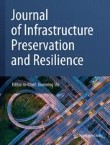Guest Editors:
Aaron Clark-Ginsberg: Behavioral/Social Scientist RAND Corporation, USA (aclarkgi@rand.org)
Ji Yun Lee: Assistant Professor Washington State University, USA (jiyun.lee@wsu.edu)
Submission Status: Open | Submission Deadline: Closed
Journal of Infrastructure Preservation and Resilience is calling for submissions to our collection: Sociotechnical perspectives to infrastructure resilience.
Infrastructure system resilience – the ability of infrastructure to maintain essential services by absorbing and/or recovering from shocks and stresses – is a sociotechnical property, contingent on the technical components of an infrastructure system, as well as underlying social processes and modes of organization and finance. It is also networked, contingent not just on the ability of a single organization or provider, but on the sets of organizations that come together as a system to collectively provide key services.
Work on sociotechnical resilience of infrastructure systems is to date relatively nascent. Despite a need for infrastructure to be well engineered and maintained, research that bridges natural, technical, and social science remains rare. Moreover, research that explores resilience from this systems perspective is also lacking, instead focusing on single firms or components not the more distended sets of systems that make up the infrastructure.
The purpose of this special issue is to lay the groundwork for advanced thinking and understanding on sociotechnical approaches to infrastructure and contribute to transforming infrastructure networks from spaces of fragility to those of resilience. To that end the journal welcomes articles and commentaries from researchers and policymakers working to assess and enhance the resilience of infrastructure systems –such as power grid, water supply network, supply chain system, and telecommunication/cyber infrastructures, and health infrastructure – through sociotechnical approaches. Specific questions focus on methods for researching sociotechnical systems, as well as sociotechnical related research and models
